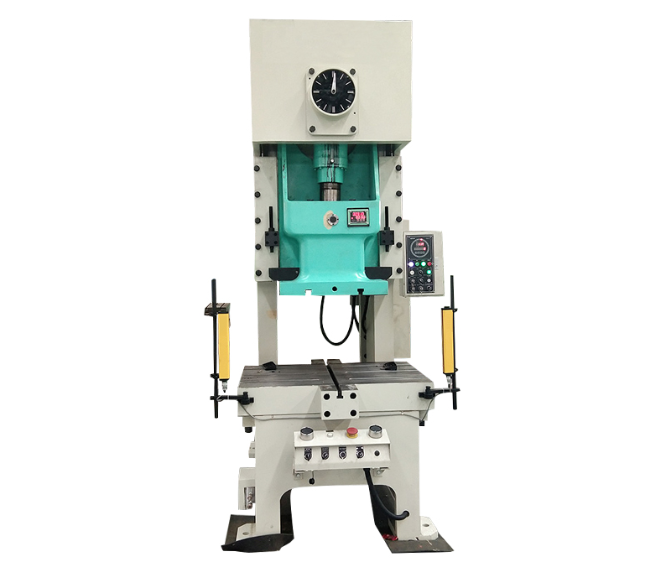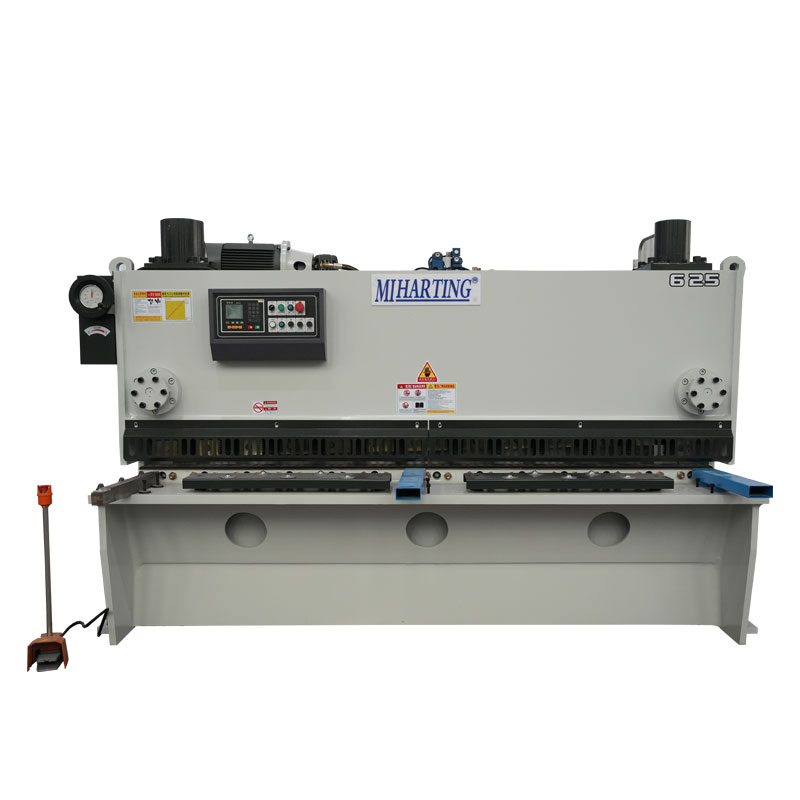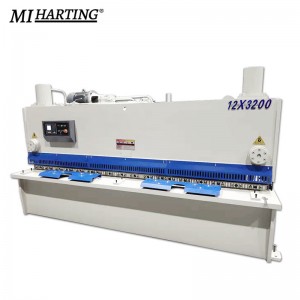What is a Power Press Machine
A power press machine , also known as a punch press or simply a punch, is a machine tool used in sheet metal fabrication to create holes, shapes, or deformations in metal workpieces. It is a versatile and widely used machine in the manufacturing industry.
Punching machines can be powered by mechanical, hydraulic, or pneumatic systems and consist of various components such as the frame, bed, ram, die set, and power source. The machine operates by clamping the workpiece between the die set and the bed, and the ram moves downwards with force, pushing the punch through the workpiece to create the desired hole or deformation.
Power press machine are used in industries such as automotive, aerospace, electronics, and construction for applications like hole punching, forming shapes, producing perforated sheets, embossing, and more. They offer advantages such as versatility, high efficiency, precision, cost-effectiveness, and flexibility. Safety measures such as operator training, machine guarding, regular maintenance, and the use of personal protective equipment are essential when operating punching machines.

Types of Power Press Machine
-
1.Mechanical Punching Machine: This type of machine uses mechanical power, such as a flywheel or a crankshaft, to generate force and perform punching operations.
-
2.Hydraulic Punching Machine: These machines utilize hydraulic power to exert force for punching. They offer high precision and are suitable for heavy-duty applications.
-
3.Pneumatic Punching Machine: Pneumatic machines use compressed air to generate force for punching. They are often used for smaller-scale operations and in industries where cleanliness is crucial.
Components and Functions of a Power Press Machine
- 1. Frame: The frame provides structural support and stability to the machine.
- 2. Bed: The bed is a flat surface where the workpiece is placed for punching.
- 3. Ram: The ram is the moving component of the machine that delivers force to the workpiece.
- 4. Die Set: The die set holds the tooling, including punches and dies, which determine the shape and size of the punched hole or deformation.
- 6. Power Source: The power source, whether mechanical, hydraulic, or pneumatic, generates the force required for punching.
Working Principle of a Power Press Machine
The working principle of a power press machine involves the following steps:
-
1. Clamping: The workpiece, usually a sheet of metal, is securely clamped between the die set and the bed of the punching machine.
-
2. Positioning: The operator positions the workpiece accurately to align with the desired location for the hole or deformation.
-
3. Activation: The power source, whether mechanical, hydraulic, or pneumatic, is activated to initiate the punching process.
-
4. Ram Movement: The ram, which is the moving component of the machine, starts to move downwards with force towards the workpiece.
-
5. Punching: As the ram descends, it pushes the punch, which is a hardened tool, through the workpiece material.
-
6. Deformation or Hole Formation: The punch creates the desired shape, either by deforming the metal or by removing a section of the material to form a hole.
-
7. Return Stroke: After the punching operation is completed, the ram returns to its initial position.
-
8. Workpiece Removal: The operator removes the punched workpiece from the machine and prepares it for further processing or use.
Applications of Power Press Machine
Punching machines are widely used in industries such as automotive, aerospace, electronics, and construction. Common applications include:
-
1. Metal Fabrication: Punching machines play a crucial role in metal fabrication processes, including the production of brackets, clips, connectors, and similar components used in various industries.
-
2. Automotive Industry: Punching machines are utilized in the automotive industry for tasks such as creating mounting holes, shaping body panels, and manufacturing various interior and exterior components.
-
3. Electrical and Electronics Industry: Punching machines help produce precise openings for switches, connectors, and cable entry points in electrical enclosures, control panels, and electronic devices.
-
4. Construction and Architecture: Punching machines are employed in the construction sector for fabricating metal structures, producing metal frames, brackets, and fixtures used in building and infrastructure projects.
-
5. Manufacturing and Assembly: Punching machines facilitate the production of components required in manufacturing and assembly processes, ranging from small parts to larger workpieces.
-
6. Custom Applications: Punching machines can be adapted and customized for specific applications, meeting the unique needs of industries such as aerospace, furniture, signage, and more.
Advantages of Using Power Press Machine
- 1. Versatility: Punching machines can perform a wide range of operations, including hole punching, forming, bending, and more, making them highly versatile in metal fabrication.
- 2. High Efficiency: These machines can achieve high production rates due to their rapid operation and automation capabilities.
- 3. Precision: Punching machines offer excellent accuracy and repeatability, ensuring consistent results.
- 4. Cost-Effective: Punching can be a cost-effective solution for mass production due to its efficiency and versatility.
- 5. Flexibility: Punching machines can handle various sizes and types of materials, allowing for flexibility in manufacturing processes.
Safety Measures and Best Practices
- 1. Operator Training: Proper training should be provided to operators to familiarize them with the machine's operation, safety protocols, and emergency procedures.
- 2. Machine Guarding: Install appropriate guards and safety devices to prevent access to hazardous areas during operation.
- 3. Regular Maintenance: Conduct routine maintenance checks and inspections to ensure the machine is in good working condition.
- 4. Personal Protective Equipment (PPE): Operators should wear appropriate PPE, such as safety glasses, gloves, and ear protection, to mitigate potential hazards.
- 5. Emergency Stop Buttons: Equip the machine with easily accessible emergency stop buttons to quickly halt operations in case of emergencies.
Comparison with Other Forming Machines
Compared to other forming machines, such as press brakes or shearing machines, punching machines excel in creating holes and performing intricate operations with speed and precision. Press brakes are primarily used for bending sheet metal, while shearing machines focus on cutting straight lines. Punching machines offer a wider range of capabilities and are often the preferred choice for hole-punching and shaping operations.
Common Materials Processed with Power Press Machine
- 1.Mild Steel
- 2.Stainless Steel
- 3.Aluminum
- 4.Copper
- 5.Brass
- 6.Galvanized Steel
- 7.Plastics
Choosing the Right Punching Machine for Your Business
- 1. Application Requirements: Determine the specific operations you need to perform, such as hole punching, forming, or embossing, and choose a machine that can accommodate those requirements.
- 2. Capacity and Power: Consider the thickness and size of the materials you will be working with and ensure the machine has sufficient capacity and power to process them effectively.
- 3. Automation and Precision: If high precision and automation are critical for your operations, look for machines equipped with advanced control systems and servo motors.
- 4. Safety Features: Assess the safety features offered by the machine, such as guards, emergency stop buttons, and safety interlocks, to ensure compliance with safety standards and protect operators.
- 5. Reputation and Support: Research reputable manufacturers with a track record of delivering quality machines and providing reliable customer support.
Choosing the Right Power Press Machine Manufacturer
- 1. Experience and Expertise: Look for a manufacturer with extensive experience in the industry and a proven track record of producing reliable and high-quality machines.
- 2. Customization Options: Choose a manufacturer that can offer customized solutions tailored to your specific requirements.
- 3. After-Sales Support: Ensure the manufacturer provides comprehensive after-sales support, including technical assistance, spare parts availability, and maintenance services.
- 4. Certifications and Standards: Check if the manufacturer complies with industry standards and holds relevant certifications, such as ISO, CE, or others.
- 5. Customer Feedback: Read reviews and testimonials from existing customers to gauge their satisfaction levels with the manufacturer's products and services.
- 6. Price and Value: Consider the pricing structure and the overall value offered by the manufacturer, taking into account factors such as machine quality, features, and support services.
As a manufacturer, MIHARTING is always committed to providing high-quality products and excellent services. Our dream is to bring China’s smart manufacturing to the world and let high-quality products shine around the world. In this era full of opportunities and challenges, we call on every partner and customer to work together to welcome future development.
We insist on being driven by innovation, winning by quality, providing excellent products and services, and creating greater value for customers. Please contact us for the best experience!
In conclusion, punching machines are essential tools in sheet metal fabrication, offering versatility, efficiency, and precision. Understanding their types, components, working principles, applications, safety measures, and how they compare to other forming machines will help you make informed decisions when choosing the right machine for your business. Selecting a reputable manufacturer is crucial to ensure reliable performance, ongoing support, and long-term success in your manufacturing operations.





